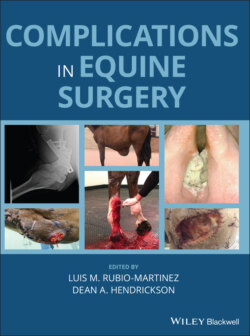Читать книгу Complications in Equine Surgery - Группа авторов - Страница 167
Pneumothorax/Hemothorax
ОглавлениеDefinition
Pneumothorax and hemothorax has been reported when the sternum and ribs are used as donor sites [20].
Risk factors
Selection of rib or sternum as donor site for bone graft
Lack of familiarity with anatomy of region of donor site
Pathogenesis
Inadvertent puncture of the thoracic or pericardial cavities during bone marrow graft harvest from the sternum or rib may result in hemothorax or pneumothorax, leading to pulmonary collapse or catastrophic cardiovascular event.
Prevention
Examination upon necropsy has revealed that the sternum of the equine patient contains between six and eight sternebrae. The preferred biopsy sites are the fourth or fifth sternebrae of adult horses [21]. It is recommended to use the more caudal sternebrae for several reasons [16].
The caudal sternebrae are covered by less muscle and have a thinner cartilaginous covering, are closer together, and contain more cancellous bone per sternebra in comparison with the more cranial sternebrae. Familiarization with the anatomy of this region is essential if sternum and ribs are to be used as donor sites for bone graft harvest. Utilization of a different donor site may result in less morbidity to the patient.
Diagnosis
Clinical signs result from damage to thoracic structures, which may include pneumothorax, hemothorax, as well as injury to the lungs, heart, or blood vessels, with resultant respiratory distress. Clinical signs of pneumothorax include dyspnea, tachypnea, increased respiratory effort and cyanotic mucous membranes [22]. Clinical signs of hemothorax are referable to hypovolemic shock, and include tachycardia, tachypnea, weak arterial pulses, pale mucous membranes, cold extremities, respiratory distress, trembling, weakness, and sweating.
Auscultation and percussion of the chest wall allow the clinician to distinguish pneumothorax from hemothorax. In patients with pneumothorax, lung sounds are absent with increased resonance percussed dorsally, while reduced lung sounds ventrally and percussion of a fluid line are typical of hemothorax [22]. Thoracic radiography and ultrasonography may aid in confirmation of pleural cavity involvement.
Monitoring
Diagnosis is made by clinical signs described and initial efforts are directed toward stabilization of the patient. Arterial blood gas sample may be performed and analyzed to assess ventilation and gas exchange to dictate further treatment. Shock may result in cases with significant blood loss or respiratory compromise.
Treatment
Emergency treatment of pneumothorax focuses on stabilization of the patient by closure of thoracic wounds and immediate removal of pleural air [22].
The wound is closed to reduce the severity of the pneumothorax and the chest is sealed temporarily.
Pleural air is removed by inserting a sterile teat cannula, 14‐gauge catheter or thoracostomy tube into the dorsal aspect of the thorax at the 11th to 15th intercostal space. Air is slowly removed using an extension set, three‐way stopcock and 60‐ml syringe. A one‐way valve is attached to allow continuous exiting flow of air upon initial removal of pleural air and fluid.
Oxygen supplementation is indicated in most cases of respiratory distress resulting from pneumothorax or hemothorax. Oxygen supplementation may be provided via nasal O2 insufflation at a flow rate of 15 L/min in adult horses [22].
Intra‐tracheal oxygen administration increases the fraction of inspired oxygen and may help to speed the absorption of air from the pleural cavity in cases of pneumothorax.
Emergency treatment of hemothorax focuses on restoring intravascular fluid volume, cardiac output, and tissue perfusion.
Draining blood from the pleural cavity may be indicated to improve ventilation and perfusion matching and decrease intrapulmonary shunting of blood if the horse demonstrates signs of respiratory distress. However, leaving blood in the chest may actually inhibit bleeding, and some of the red blood cells may autotransfuse [22].
Expected outcome
Puncture of the thoracic or pericardial cavity may result in pulmonary collapse or catastrophic cardiovascular event. Euthanasia may be necessary if emergency medical intervention is not sufficient to stabilize the patient.
